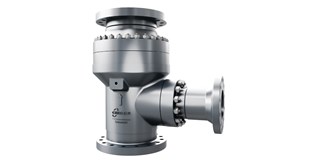An efficient control valve system?
Control valves for pump protection operate as part of a multi-component system. A complete installation consists of a main line check valve, a flow meter, a special piping T-piece for the recirculation line, a control unit, and the control valve itself with actuator and positioner.
These function in a stepwise manner: During pump operation the flow is continuously measured by the flow meter, the results are then transferred to the control unit, and in case the required minimum flow of the pump is lower than defined, the control unit tries to open the control valve. The valve then ensures the minimum flow of the pump, and damage of the pump due to cavitation or overheating is avoided.
A familiar axiom, constantly proven in engineering, should give pump OEMs and plant operators pause—less is more. Ultimately, the control valve solution is a complex one. In addition to the components mentioned, an external power supply is required to operate the system. Therefore, any lapse in power, or malfunction or breakdown of components, or any break in their linkage, could result in failure. For a design meant to act as a backstop against failure on a much larger scale, the margin for malfunction should be limited as much as possible.
Negative implications of the multi-part system are also apparent from the perspective of continuous observation. Each element of the installation also requires its own maintenance schedule, each requires its own installation, and the complexity of the system entails greater upfront installation and commissioning costs than a simpler solution.
The design of the system leaves an opportunity for more efficient operation largely out of reach. Pump protection with a control valve usually operates as a binary function. Either the valve is open and supplying the minimum flow or the valve is closed. Modulating this function would result in vastly improved operational efficiency. However, creating a modulating function with a control valve is a complicated task. Switch points must be defined and controlled continuously by the operating system, with the control system and flow meter working in unison. So, the standard on/off function of a control valve solution often results in vibration and coupling problems at the pump due to a sudden drop at the switch point.
All-in-one pump protection
An alternative pump protection solution enables operational efficiency for large pumps that control valve systems cannot. Relative simplicity of design accounts for the difference in functionality.
Automatic Recirculation Valves (ARVs) from CIRCOR | SCHROEDAHL combine a high-quality check valve with a bypass control mechanism. This bypass system utilizes a pressure-independent and low-friction mechanical control. With a robust control bushing design and a low bypass switch point, the valve self-modulates to allow partial load operation at lower energy consumption. This results in operational cost savings for the life of the valve.
A consolidated mechanical pump protection design as demonstrated by ARVs adds efficiency in other ways as well. Importantly, these valves self-actuate without the need for separate power, or a separate control system. Partly by eliminating these other components, partly because of the minimized cast housing dimensions for reduced installation weight, ARV installations costs only one-third of the installation costs associated with a control valve system, with its component check valve and instrumentation devices. While control valve systems are only confirmed after commissioning, and then require continual checking, no actions or modifications are needed for commissioning ARVs—pump protection begins immediately upon installation.
Furthermore, the valve’s straightforward and integrated engineering provides improved valve function. An optimized balance of the main check valve behavior and the bypass operation against typical fluid pulsations results in greater pump stability for less vibration and fewer pump coupling or gear problems. Plus, designed with lifespan in mind, these mechanical units offer maintenance-free operation.
Simply gathering a number of functions into a single unit, though, does not necessarily grant all the efficiency benefits outlined here. One potential source of inefficiency even in a pump protection valve is the bypass control mechanism. The ARV avoids two potential pitfalls. First, a sensitive pilot bypass control mechanism can be blocked, leading to pump damage. Second, a pressure-sensitive bypass control system can amplify the hysteresis effect.
Choosing an efficient pump protection solution
Combined pump protection valves such as SCHROEDAHL’s Automatic Recirculation Valves offer a number of efficiency benefits compared to standard control valve installations, including installation, operation, and maintenance. This efficiency largely stems from the elegant simplicity of a mechanical design that delivers flow-sensitive, self-actuating, and self-modulating performance. Nevertheless, while available for low- and high-pressure service in trim designs for virtually every pump size, the solution is not universally ideal. The only limit we know of for ARVs is that the unity of the valve can become cumbersome at some sizes and for some applications. For example, for exceptionally large power plants (over 500 MW), plant engineering companies often require a control valve solution, since an ARV for such a massive boiler would be a quite hefty unique part. In short, there are times when the negatives of a multi-part non-mechanical system can be overlooked. To identify and implement the most efficient solution for a particular application, plant engineers can of course consult the pump protection experts at SCHROEDAHL who can advise on both solutions: the ARV and the control valve technology.




